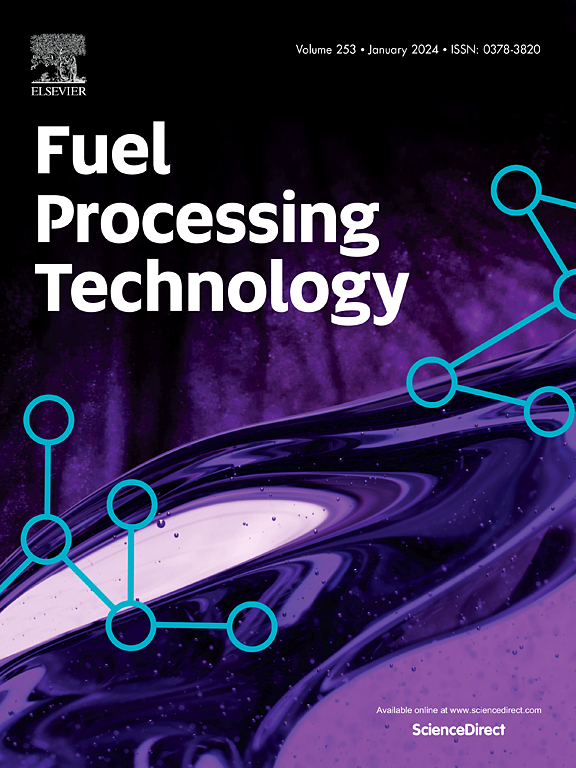Methane conversion to aromatics via chemical synergy with OCM: Effect of periodic operation, temperature profile, and catalyst loading
IF 7.2
2区 工程技术
Q1 CHEMISTRY, APPLIED
引用次数: 0
Abstract
The transition from indirect to direct methane conversion marks a significant advancement in chemical processing. One promising direct reaction is methane dehydroaromatization, which converts methane to aromatics in a single step with zero CO2 emissions. However, the commercialization of MDA faces major challenges including thermodynamic limitations, rapid catalyst deactivation, and high temperature requirements. Integrating MDA with another reaction offers a potential solution to these challenges combined. This work explores the potential opportunities and limitations for chemical synergy when coupling the oxidative coupling of methane (OCM) to MDA through mass integration. Experimental studies were conducted by passing the oxidative coupling of methane (OCM) reactor effluent to a downstream MDA reactor. Periodic feeding of OCM to the MDA catalyst showed limited improvement, indicating that OCM composition alone does not maintain stable MDA performance. Varying the temperature over time in MDA reactor demonstrated that C2 coming from OCM contribute to aromatic production even at low temperatures (450 °C). However, at such temperature, the conversion of CO2 to CO and CH4 to aromatics does not occur, highlighting the need for high operating temperatures in the OCM-MDA coupling process. The coupling of OCM and MDA was tested with different MDA space velocities as 3750, 1875, and 1250 mL/g/h, corresponding to 0.2 g, 0.4 g and 0.6 g catalyst loading, respectively. The case of 1250 mL/g/h maintained a stable 14 % conversion and 2.5 % yield of benzene over 10 h, converting all CO2 to CO. Characterization using TGA, Raman spectroscopy, and XPS on spent catalysts indicated limited carbon removal by OCM effluent, and confirmed that CO2 is causing the oxidation of Mo2C to MoOx. A reaction scheme for the OCM-MDA coupling using Mo/ZSM-5 is proposed to guide future exploration of this promising two-step process.
甲烷通过与OCM的化学协同作用转化为芳烃:周期性操作、温度分布和催化剂负载的影响
甲烷从间接转化到直接转化标志着化学加工的重大进步。一个很有前途的直接反应是甲烷脱氢芳构化,它在一个步骤中将甲烷转化为芳烃,二氧化碳排放量为零。然而,MDA的商业化面临着热力学限制、催化剂快速失活和高温要求等主要挑战。将MDA与另一种反应集成为这些挑战提供了一种潜在的解决方案。这项工作探讨了当甲烷(OCM)通过质量整合与MDA氧化偶联时,化学协同作用的潜在机会和局限性。通过将甲烷(OCM)反应器出水氧化偶联至下游的MDA反应器进行了实验研究。定期向MDA催化剂中添加OCM的效果有限,这表明单独添加OCM并不能维持MDA的稳定性能。在MDA反应器中随时间变化的温度表明,即使在较低的温度(450°C)下,来自OCM的C2也有助于芳香的生成。然而,在这样的温度下,CO2转化为CO和CH4转化为芳烃不会发生,这突出了OCM-MDA耦合过程需要较高的操作温度。在催化剂负载分别为0.2 g、0.4 g和0.6 g时,以3750、1875和1250 mL/g/h的MDA空速测试OCM与MDA的耦合。在1250 mL/g/h的条件下,10小时内苯的转化率稳定在14%,苯的产率为2.5%,将所有的CO2转化为CO。利用TGA、拉曼光谱和XPS对废催化剂进行表征表明,OCM废水对碳的去除有限,并证实了CO2导致Mo2C氧化为MoOx。提出了一种使用Mo/ZSM-5进行OCM-MDA偶联的反应方案,以指导未来对这一有前途的两步法的探索。
本文章由计算机程序翻译,如有差异,请以英文原文为准。
求助全文
约1分钟内获得全文
求助全文
来源期刊

Fuel Processing Technology
工程技术-工程:化工
CiteScore
13.20
自引率
9.30%
发文量
398
审稿时长
26 days
期刊介绍:
Fuel Processing Technology (FPT) deals with the scientific and technological aspects of converting fossil and renewable resources to clean fuels, value-added chemicals, fuel-related advanced carbon materials and by-products. In addition to the traditional non-nuclear fossil fuels, biomass and wastes, papers on the integration of renewables such as solar and wind energy and energy storage into the fuel processing processes, as well as papers on the production and conversion of non-carbon-containing fuels such as hydrogen and ammonia, are also welcome. While chemical conversion is emphasized, papers on advanced physical conversion processes are also considered for publication in FPT. Papers on the fundamental aspects of fuel structure and properties will also be considered.
 求助内容:
求助内容: 应助结果提醒方式:
应助结果提醒方式:


